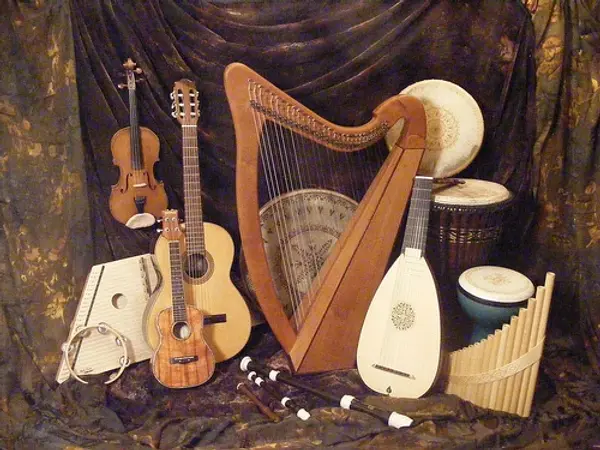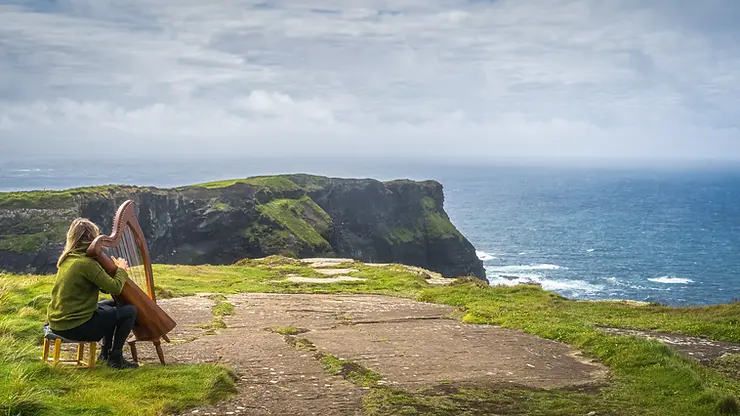A Brief History of Irish Music: From Ancient Origins to Modern Traditions
The history of Irish music is a fascinating tale that dates back centuries, intertwining with Ireland’s cultural, social, and political landscape. Let’s delve into some major milestones that have shaped and defined this beloved musical tradition.
Ancient Celtic Influences
The earliest roots of Irish music can be traced back to the ancient Celtic era, where music played a significant role in Celtic rituals, ceremonies, and daily life. The Celts, who settled in Ireland around 500 BC, brought with them a rich musical heritage, characterised by haunting, evocative melodies played on ancient instruments such as the harp, lyre, and horn.
Christian Influence
The arrival of Saint Patrick in the 5th century heralded the spread of Christianity in Ireland and its subsequent impact on music. Monastic settlements became centres of learning and artistic activity, leading to the transcription of Irish hymns and religious chants. Notable examples include the music of Saint Colmcille and the poetic hymns of Saint Brigit.
As Irish society developed, so did the music. From the 16th to the 18th century, Irish music flourished through lively jigs, reels, hornpipes, and ballads. These songs, accompanied by instruments like the fiddle, tin whistle, and bodhrán, provided a soundtrack to daily life, bringing people together to celebrate, dance, and tell stories.

The Irish Harp
One of the most iconic symbols of traditional Irish music is the harp. It was widely played during the medieval period, with harpers held in high esteem nationwide. The Irish harp became a potent symbol of Irish identity and resistance during times of political turmoil, as seen in the emblematic Harp of Brian Boru, which became a national symbol.
The Great Irish Famine and Emigration
The Great Hunger of the mid-19th century had a profound impact on Irish music. As a result of economic hardship and widespread emigration, Irish music spread across the world with Irish immigrants. The music began to transform and adapt to new environments, mingling with other musical traditions, particularly in the United States, leading to the birth of Irish-American music.

The Celtic Revival
In the late 19th and early 20th centuries, a cultural movement known as the Celtic Revival emerged, rekindling interest in Ireland’s traditional music. Pioneers such as Douglas Hyde, Lady Gregory, and William Butler Yeats sought to revive and preserve the Irish language, folklore, and music. Organisations like the Gaelic League and the Feis Ceoil played essential roles in promoting traditional music and dance.
Evolution and Global Recognition
In the latter half of the 20th century, Irish music experienced a dynamic renaissance that led to its international recognition and a significant expansion of its audience. This period saw the emergence of talented artists, influential bands, and organisations dedicated to promoting and preserving Irish music.
During the 1960s and 1970s, several influential bands emerged, pushing the boundaries of traditional Irish music while honouring its roots. The Chieftains, formed in 1962, played a pivotal role in popularising Irish music worldwide. Collaborating with renowned artists from diverse genres, they created a distinctive sound that blended traditional Irish melodies with elements of classical, folk, and rock.
Another influential group, Planxty, formed in the early 1970s, combined stunning instrumental prowess with powerful vocal harmonies, revolutionising traditional Irish music. Their innovative arrangements and socially conscious lyrics attracted a young audience, bringing fresh energy to the genre.
The Dubliners, founded in 1962, also played a huge role in the boom of Irish folk songs, ballads, and drinking songs. Their energetic performances and charismatic stage presence endeared them to audiences at home and abroad, helping to cement Irish music’s place on the international stage.

Comhaltas Ceoltóirí Éireann
Founded in 1951, Comhaltas Ceoltóirí Éireann (CCÉ) has been instrumental in promoting and preserving traditional Irish music, song, and dance. The organisation organises classes, competitions, festivals, and concerts, creating opportunities for musicians to learn, perform, and connect with other artists. CCÉ has been crucial in ensuring the transmission of regional styles, techniques, and repertoire from one generation to another.
Traditional music sessions, both informal gatherings and organised sessions, became increasingly popular during the modern era. Pubs, festivals, and community centres became vibrant spaces for musicians to come together, share tunes, and showcase their skills. These sessions not only preserved the tradition of Irish music but also provided a platform for musicians to collaborate, experiment, and keep the music alive.
Global Success of Irish Artists
Irish music achieved unprecedented international success during the modern era. Artists such as Enya, Clannad, and The Cranberries spearheaded a movement that fused traditional Irish influences with contemporary sounds, captivating audiences worldwide.
Enya’s ethereal vocals, combined with layers of intricate instrumental arrangements, created a unique sound that transcended boundaries. Clannad, known for their harmonies and fusion of traditional Irish music with elements of folk and ambient soundscapes, gained popularity through their hauntingly beautiful soundtrack for the television series “Harry’s Game.” The Cranberries, with their alternative rock sound and powerful lead vocalist Dolores O’Riordan, brought a fresh and distinctive flavour to Irish music.
Riverdance
The 1994 Eurovision interval act, “Riverdance,” burst onto the international stage and became a global sensation. This exhilarating fusion of Irish music, song, and dance captivated audiences around the world, elevating traditional Irish dance to unprecedented levels of popularity. “Riverdance” played a significant role in bringing Irish music and culture to mainstream attention, sparking a renewed interest in traditional forms of Irish dance and music.

Festivals and Celebrations today
Ireland hosts various festivals and celebrations dedicated to Irish music, ensuring its continuous growth and recognition. The annual Tradfest in Dublin, established in 2006, offers a vibrant showcase of Irish traditional music, attracting renowned artists and enthusiastic audiences from around the world.
The Fleadh Cheoil, the world’s largest Irish music festival, founded in 1951 by CCÉ, brings together thousands of musicians, singers, and dancers from across many nationalities for performances and competitions.
Events like these provide platforms for established and emerging artists to showcase their talents and ensure that Irish music remains at the forefront of cultural celebrations both at home and abroad.
It’s TradFest this week in Dublin so make sure to get yourself out in the city and enjoy some fantastic live music and Irish dancing!

